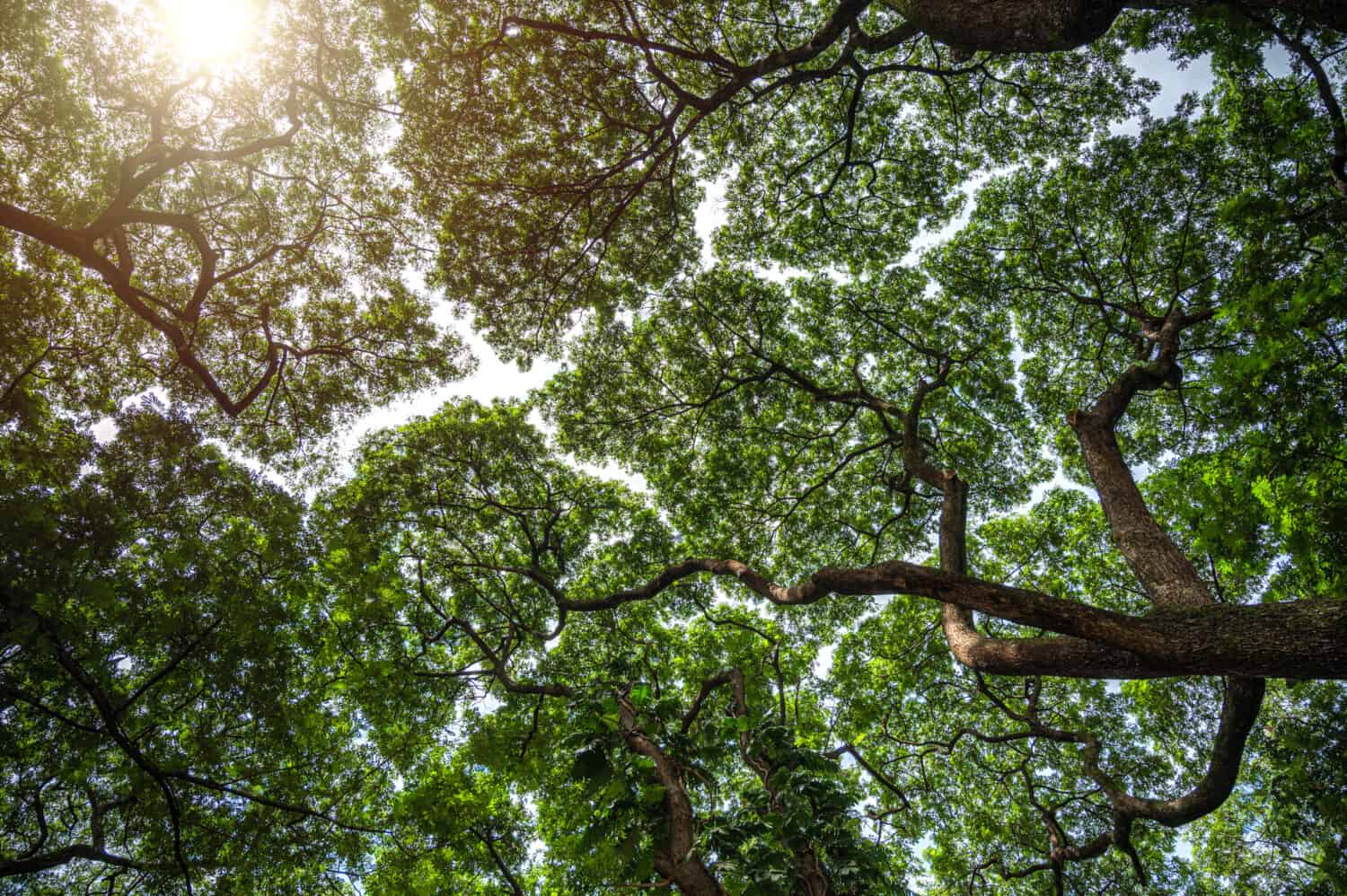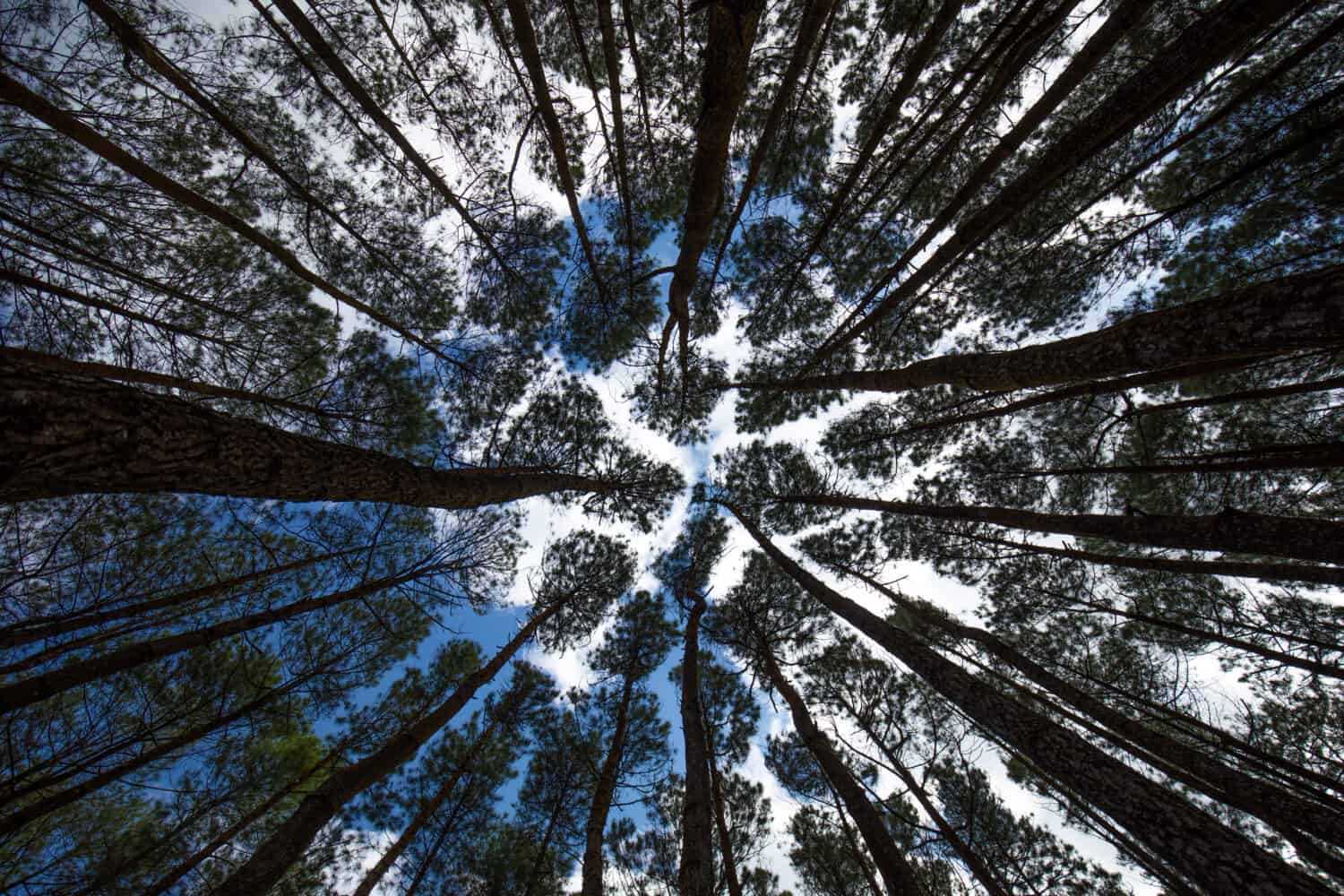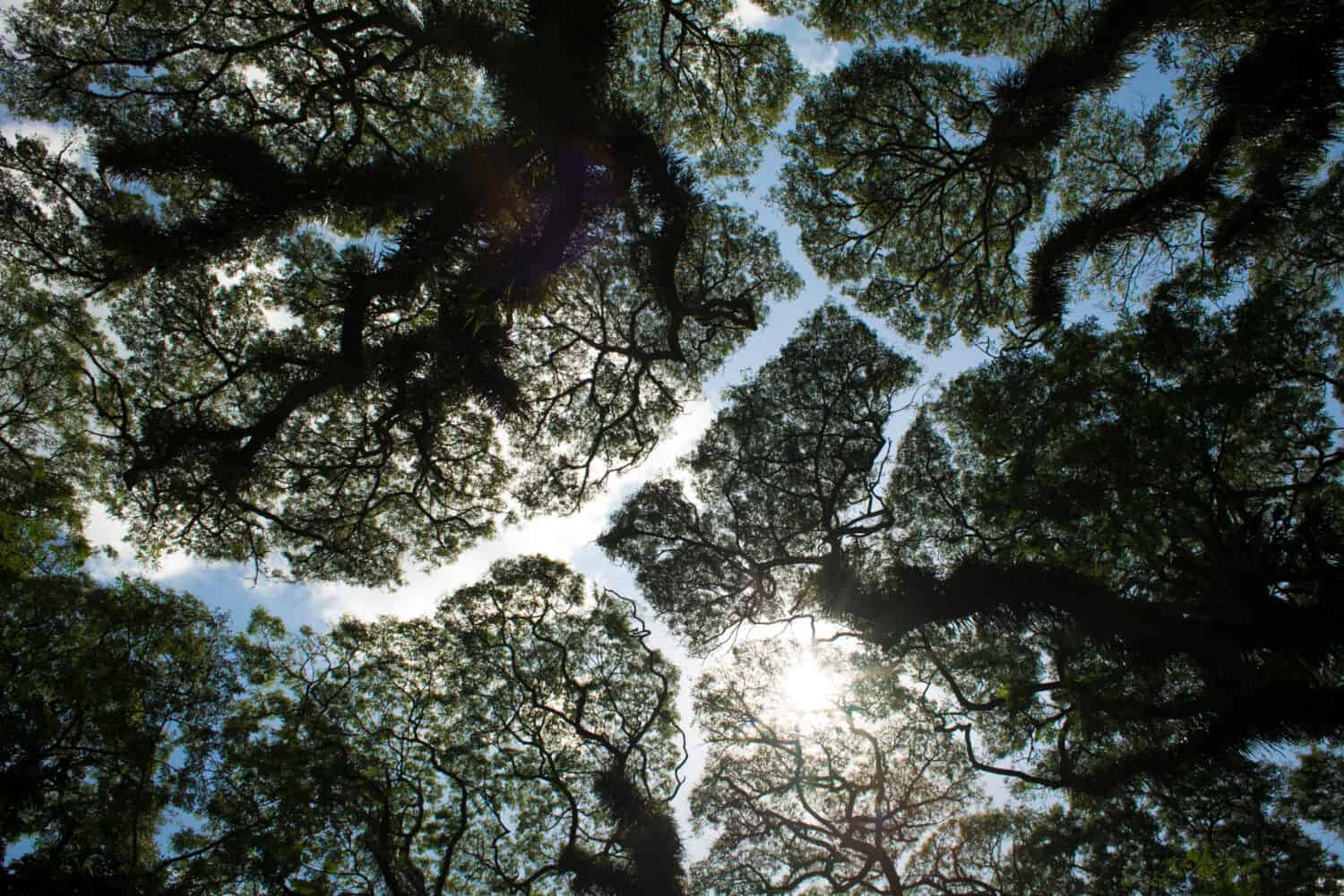Trees are an integral part of the experience of life on earth. They provide oxygen and improve air quality, give homes and habitats to thousands upon thousands – even millions – of species, and they help to conserve water. We love trees for their ability to provide shelter on a hot day, insulate us on cold days, and give us precious materials for our papers, houses, and art. There is really no end to the ways that trees contribute to the world around them. Today, we’ll be exploring a phenomenon unique to certain tree species – crown shyness. Also known as “canopy shyness”, this adaptation helps trees stay healthy and thrive in their environments. We’re going to look at what crown shyness is, how it works, and why it happens. Are you ready?
What is Crown Shyness?

This is a fantastic example of crown shyness. Do you see the channels of sky through the canopy of leaves?
©Chanawin Tepprasitsakda/Shutterstock.com
Crown shyness is a phenomenon that occurs between trees of certain species and sometimes individual trees of separate species. In order to best describe crown shyness, we’re going to take you on a walk through the woods. We enter a forest full of trees, surrounded by maple, elm, birch, and oak. As we get deeper into the woods, we stop to observe golden hour light trickling down onto the forest floor. This is a bright forest, where the sun reaches the forest floor foliage easily. We lay down on a bed of slowly decaying leaves, their crisp top layer covering rich, dark soil. As we stare at the canopy above, we trace our fingers along channels of sky between the trees, making little rivers of clouds and blue that flow between the treetops.
These gaps in the the ceiling of the forest are crown shyness. Narrow channels cut lines between the trees and let the light of the sun reach the forest floor below their vast canopies. This happens most often in temperate deciduous forests. Scientists have been studying this phenomenon since the 1920s, and they’ve found that it doesn’t happen to all trees. Let’s talk about why it happens and then we’ll talk about what trees experience it.
Why Does Crown Shyness Happen?

An example of crown shyness in a species of pine trees.
©Sirhcsky/Shutterstock.com
The precise cause of crown shyness is still a bit of a mystery to scientists, dendrologists, and arborists. Several hypotheses do exist for this phenomenon, and we’ll go over a few of them now.
Crown Shyness as an Adaptive Mechanism
One of the leading schools of thought on crown shyness is that certain varieties of trees have had to adapt and evolve to continue to thrive. Have you heard of competition relationships in wildlife? Competition is sometimes argued to be a symbiotic relationship, but others state that it can’t be since species do not have to interact with one another to experience the relationship. Competition is, essentially, the fight for resources between different species. A great example is hyenas and lions sharing the same hunting ground. If one out-hunts the other, the other will have to leave, evolve, or die. In trees, it is hypothesized that crown shyness is an adaptation to avoid the competition for resources. By creating the physical gap, there is more potential for access to sunlight, water, and nutrients.
Social Distancing
Another strong hypothesis about crown shyness is that some varieties of trees have evolved this mechanism to avoid spreading disease. There are actually a ton of different tree diseases, and some trees have to find ways to defend themselves from catching them. Some of these diseases include hardwood decay, brown spot needle blight, littleleaf disease, and a fungus known as “tar spot”. Not all of these diseases or fungal infections are deadly to trees, but they can make thriving much harder. It is possible that crown shyness helps prevent the spread of some of these diseases, keeping the whole of the forest healthier.
Allelopathy
This explanation for crown shyness is one of the most interesting ones to think about. Allelopathy is a word formed in the botany community to describe the transmission of messages from one plant to another using chemical signals. Trees and plants are known to produce a series of different chemical compounds that have positive or negative effects on their neighboring plants. The chemical compounds described here are known as “allelochemicals”. How interesting is it to think that crown shyness could be caused by a complex chemical communication?
This relationship occurs most often between plants and trees of the same species, but it is not inhibited to communication with only one species. While plants and trees are more likely to be able to communicate with one another by sharing a common genus or species, interspecies communications are possible and have been observed. In this case, allelopathy would be used to reduce competition, but one study, called “Allelopathy as an Evolutionary Game” speaks on this chemical interaction being used to prevent competing species from getting access to resources.
Chafing
The fourth hypothesis we will touch on is that crown shyness is a result of tree canopies rubbing against one another on windy days. The chafing of leaves and branches on these days could be the cause of the crown shyness. This is a strong hypothesis, though many people likely don’t like to think about the brutality of all wildlife, flora and fauna. Physical abrasion cannot be the only way living beings thrive. We like to turn our eyes to fonder forms of symbiosis, such as commensalism or mutualism. However, a distaste for brutality doesn’t exclude it from any food chain, even in trees.
One 1984 study seems to back the chafing hypothesis. This research took place in Costa Rica in an area with a lot of black mangrove trees. 22 pairs of trees were selected, based on having similar heights and proximities. The scientists had to observe a number of environmental stimulants to the environment, but their focus was on how the trees grew in still conditions versus how they grew in consistently windy ones. In this study, the researchers found that these trees were more likely to intertwine with one another in still conditions. In windy conditions, the interlocking pattern of the trees caused breaking in branches and twigs and a greater loss of leaves. These observations suggested that the crown shyness was a direct result of interaction between trees.
An Interesting Note on one Hypothesis
In the first hypothesis, we spoke about how this phenomenon might be an evolution in trees to avoid competition. This would indicate that trees actually have the ability to sense light and stop growing when they encroach on the canopies and foliage of other trees. This idea is not that far-fetched. Most plants absolutely require light to grow and thrive. We can take houseplants as a great example of that. A houseplant in a bright window will grow toward the window in order to get more access to sunlight. This does imply that plants, in their way, know exactly where the sun is.
What Trees Experience Crown Shyness?

Crown shyness in a unique grouping of trees in Banyuwangi, Indonesia.
©Julian Somadewa/Shutterstock.com
As we stated before, this phenomenon only impact certain varieties of trees. The Natural History Museum specifically notes the documentation of crown shyness in tree varieties of both deciduous and coniferous descent. The three trees species they call upon in their exploration of crown shyness are the lodgepole pine (Pinus contorta), the black mangrove (Avicennia germinans), and the Japanese larch (Larix kaempferi). Let’s look at a larger list of trees with crown shyness. Once again, we’ll state that a lot of tree varieties in temperate climates and deciduous forests are more likely to experience this phenomenon.
- Some species of eucalypt.
- Schefflera pittieri
- Clusia alata
- Species of Dryobalanops (confined to Sumatra, Peninsular Malaysia, and Borneo)
- European oak
- Mixed forests of Castanopsis cuspidata and Chamaecyparis obtusa as observed in this article on “wider crown shyness between broad-leaves tree species than between coniferous tree species in a mixed forest of Castanopsis cuspidata and Chamaecyparis obtusa“.
This is not an extensive list. Some people have claimed seeing this in maple trees, oak trees, and elm trees. Further research is required to find out how many species have developed this trait and why it happens. It is, perhaps a mixture of reasonings, and could occur in more and more tree species as time goes on. Regardless, it’s a good reason to take a moment to gaze upward when walking in your local forests.
The photo featured at the top of this post is © Akarawut Lohacharoenvanich/iStock via Getty Images
Thank you for reading! Have some feedback for us? Contact the AZ Animals editorial team.







